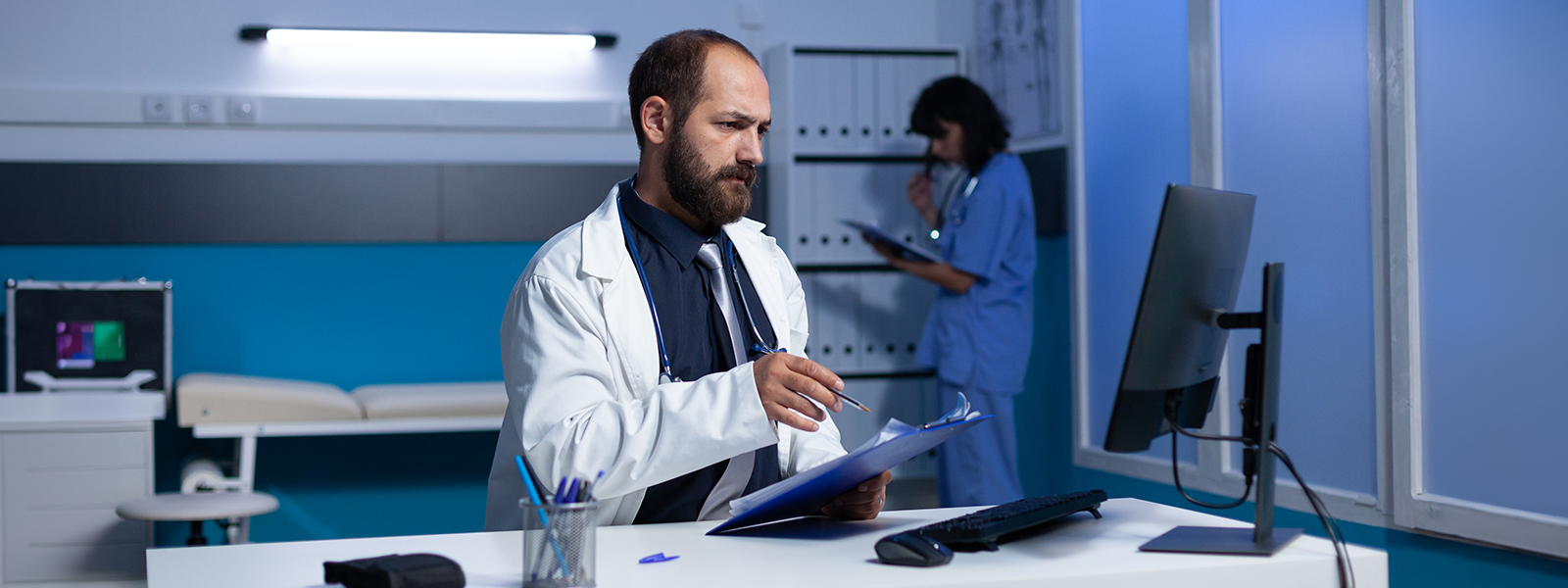Sick of hospital visits and endless appointments? What if your smartwatch could chat with your doctor, sending real-time health data that empowers both of you for proactive care? Imagine a future where you don't just react to health concerns but prevent them altogether.
The healthcare industry stands at the cusp of a technological revolution, driven by the transformative power of the Internet of Things (IoT). The integration of IoT is poised to disrupt traditional models and pave the way for a future where personalized, data-driven, and efficient care becomes the norm. IoT seamlessly interconnects devices, systems, and stakeholders, enabling a paradigm shift that promises to enhance patient outcomes, streamline operations, and optimize resource allocation. As per a Mckinsey report, healthcare organizations that have adopted IoT solutions report an average of 15% operational cost savings and a 25% increase in patient engagement.
IoT finds its niche in healthcare through the concept of the Internet of Medical Things (IoMT) and the Internet of Healthcare Things (IoHT). IoMT primarily revolves around interconnected medical devices and applications dedicated to collecting and transmitting healthcare data. On the other hand, IoHT extends its reach beyond medical devices to encompass various elements of healthcare infrastructure, systems, and networks. This broader spectrum of IoHT includes not only medical devices but also the entire ecosystem supporting healthcare delivery, from hospital networks to patient management systems. This distinction highlights the multifaceted nature of IoT's role in healthcare, emphasizing its ability to enhance connectivity, efficiency, and data exchange across the entire healthcare landscape.
IoMT and IoHT Stages
The evolution of IoMT and IoHT can be categorized into three stages:
- Connectivity: The initial stage involves the integration of medical devices and systems to establish connectivity. This enables data capture and transmission, laying the foundation for further advancements.
- Data Utilization: In the second stage, emphasis is placed on leveraging the collected data for insights and decision-making. Advanced analytics and machine learning algorithms are employed to derive actionable intelligence from healthcare data, facilitating personalized care and predictive interventions.
- Interoperability and Integration: The final stage focuses on achieving seamless interoperability and integration across diverse healthcare platforms and stakeholders. This interoperability enables real-time collaboration, streamlined workflows, and enhanced patient engagement.
The Technical Framework of IoT in Healthcare
At its core, IoT in healthcare revolves around the seamless integration of medical devices, connectivity solutions, data analytics platforms, and robust security measures. This intricate ecosystem enables the continuous monitoring, collection, and analysis of patient data, facilitating informed decision-making and personalized care delivery.
- Medical Devices Connectivity: Central to IoT in healthcare is the interconnectivity of medical devices, ranging from wearable health devices and implantable sensors to diagnostic equipment and treatment devices. These devices are equipped with sensors and actuators that capture real-time data on vital signs, physiological parameters, and patient behaviors. Through wireless communication protocols such as Bluetooth, Wi-Fi, and cellular networks, this data is transmitted to centralized healthcare systems for analysis and interpretation.
- Healthcare Data Security: With the proliferation of interconnected devices and the transmission of sensitive healthcare data, ensuring robust cybersecurity measures is paramount. Healthcare organizations must implement encryption protocols, access controls, and intrusion detection systems to safeguard patient information from unauthorized access, data breaches, and cyber threats. Compliance with regulatory standards such as HIPAA is essential to maintain data integrity and patient privacy.
The IoT Power of Connectivity
Implementing IoT in healthcare requires a robust and secure technological infrastructure. At the core of this infrastructure lies a network of interconnected devices and systems, facilitated by various connectivity solutions. Wireless technologies such as Wi-Fi, Bluetooth, and cellular networks enable seamless data transmission between devices, systems, and stakeholders, ensuring real-time communication and data exchange.
Cloud computing plays a pivotal role in the healthcare IoT solutions, providing scalable and secure platforms for storing, processing, and analyzing the vast amounts of healthcare data generated by IoT devices. Advanced analytics tools and machine learning algorithms process this data, extracting valuable insights and enabling predictive modeling, which informs proactive healthcare interventions and optimizes resource allocation.
Underpinning this technological infrastructure is a robust cybersecurity framework. As the volume of sensitive patient data transmitted and stored increases, ensuring data privacy and security becomes paramount. Robust security measures, such as encryption, authentication, and access control, safeguard sensitive information and ensure compliance with regulations, fostering trust and confidence in the IoT healthcare ecosystem. As per MarketsandMarkets, the global IoT healthcare market is projected to increase from $127.7 billion in 2023 to $289.2 billion by 2028, with a compound annual growth rate of 17.8%.
IoT Transforming Patient Care
The transformative potential of IoT in healthcare is evident across numerous applications, revolutionizing the way patient care is delivered and experienced.
- Remote Patient Monitoring (RPM): IoT enables continuous remote monitoring of patient health metrics, allowing healthcare providers to track vital signs, medication adherence, and disease progression in real-time. Wearable devices such as smartwatches, fitness trackers, and medical-grade sensors empower patients to actively participate in their care while minimizing the need for frequent hospital visits. RPM facilitates early intervention, reduces hospital readmissions, and enhances patient outcomes, particularly for individuals with chronic conditions such as diabetes, hypertension, and heart disease.
- Telemedicine and Virtual Care: IoT solutions enable virtual consultations, telemedicine appointments, and remote diagnosis through video conferencing platforms, mobile applications, and connected medical devices. This virtual care delivery model improves access to healthcare services, particularly in underserved rural areas and remote regions. By leveraging IoT-enabled telehealth technologies, healthcare providers can extend their reach, reduce appointment wait times, and deliver timely interventions to patients, irrespective of geographical barriers.
- Chronic Disease Management: By integrating IoT solutions, healthcare providers can remotely monitor chronic conditions such as diabetes, heart disease, and respiratory disorders. Real-time data analysis enables timely interventions, medication adjustments, and lifestyle modifications, improving disease management and quality of life. IoMT devices like smart insulin pumps and continuous glucose monitors (CGMs) empower patients with diabetes to manage their condition effectively at home, reducing hospital visits.
- Smart Facilities and Asset Tracking: IoT-enabled building automation systems optimize energy usage, environmental monitoring, and facility operations, ensuring a safe and efficient healthcare environment. Furthermore, real-time asset tracking solutions facilitate effective management of medical equipment, supplies, and medications, reducing waste and optimizing inventory management.
- Predictive Analytics and Population Health Management: IoT-generated healthcare data serves as a valuable resource for predictive analytics and population health management initiatives. Advanced machine learning algorithms analyze large datasets to identify trends, predict disease outbreaks, and stratify patient populations based on risk factors. By leveraging predictive analytics, healthcare organizations can proactively allocate resources, implement preventive interventions, and improve population health outcomes while optimizing healthcare delivery efficiency and cost-effectiveness.
Challenges and Opportunities
While the disruptive influence of IoT in healthcare holds immense promise, it is not without its challenges. Data privacy and security concerns, interoperability issues, and the need for robust regulatory frameworks are among the key obstacles that must be addressed to fully realize the potential of this transformative technology.
Nonetheless, the opportunities presented by IoT in healthcare are vast and compelling. From personalized medicine and predictive analytics to streamlined supply chains and optimized resource allocation, the integration of IoT solutions is poised to reshape the healthcare landscape, fostering a future where patients receive better care, healthcare organizations operate more efficiently, and innovation drives continuous improvement.
As the healthcare industry continues to navigate the challenges of delivering high-quality, accessible, and cost-effective care, embracing the disruptive influence of IoT becomes an imperative. By harnessing the power of interconnected devices, data-driven insights, and innovative solutions, healthcare providers can unlock new frontiers in patient care, operational excellence, and sustainable growth, ultimately paving the way for a more resilient and transformative healthcare ecosystem.
Conclusion
The future of healthcare is changing rapidly. Imagine a world where medical devices talk to each other, sending real-time data to doctors for earlier interventions. This is the promise of IoMT and IoHT. Studies show this can save money, improve patient involvement, and make healthcare systems more efficient. As technology gets better, devices and platforms will work together seamlessly, allowing doctors, patients, and specialists to collaborate in real-time. This will empower patients to manage their health and enable doctors to provide more precise care. There are challenges, though. Security is vital to protect patient privacy. Devices and platforms need to use the same language to share data smoothly. Finally, clear rules are needed to address ethical concerns and build trust. Despite these challenges, the future of IoMT and IoHT in healthcare is promising. By working together, technology developers, healthcare providers, and regulators can bring in the full potential of this digital revolution, creating a patient-centered, data-driven, and efficient healthcare system.





